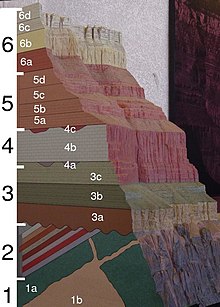Geological formation
The term was used by Abraham Gottlob Werner in his theory of the origin of the Earth, which was developed over the period from 1774 to his death in 1817.[3] The concept became increasingly formalized over time and is now codified in such works as the North American Stratigraphic Code and its counterparts in other regions.The lithology of a formation includes characteristics such as chemical and mineralogical composition, texture, color, primary depositional structures, fossils regarded as rock-forming particles, or other organic materials such as coal or kerogen.The divisions of the geological time scale were described and put in chronological order by the geologists and stratigraphers of the 18th and 19th centuries.[11] "Formation" is also used informally to describe the odd shapes (forms) that rocks acquire through erosional or depositional processes.



cross sectionGrand Canyongroupslithologystratigraphic columnlithostratigraphystratathicknessAbraham Gottlob WernerGeologic mapsstructural geologyPermianJurassicColorado PlateaustratigraphyCapitol Reef National ParkCanyonlands National ParkNavajo SandstoneKayenta FormationWingate SandstoneChinle FormationMoenkopi FormationCutler FormationGlen Canyon National Recreation AreaAustraliaSummerville Formationdepositional structuresfossilskerogentaxonomyMorrison FormationMorrison, ColoradoKaibab LimestoneKaibab Plateaustratotypetype sectionbiostratigraphic unitspaleontologicalchronostratigraphic unitschemostratigraphic unitsgeologistsoutcropsgeologic timelaw of superpositiongeological time scalesedimentary rockmetamorphic rocksvolcanic rockslithodemesstalactitesstalagmitesGeochronologyList of rock formationsList of fossil sitesBibcode